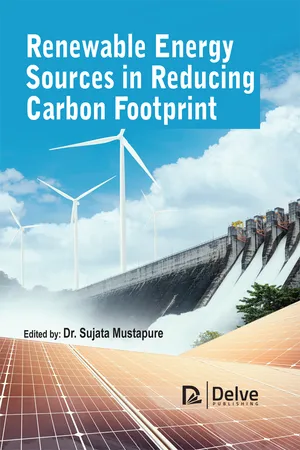
- 374 pages
- English
- PDF
- Available on iOS & Android
Renewable Energy Sources in Reducing Carbon Footprint
About this book
The renewable energy sector employs over million people worldwide, with technology being the industry leader in employment. Most newly installed electricity capacity worldwide is made up of renewable energy sources, which are also becoming more and more affordable. More than 20 percent of the energy supply in many countries around the world currently comes from renewable sources. The cheapest new-build electricity comes from onshore wind or photovoltaic solar in the majority of countries. Renewably sourced energy helps lessen dependency on carbon-intensive energy sources, which lowers green-house gas emissions, by dispensing with the need for fossil fuel-based power generation. This change is essential to reducing the negative effects of climate change, such as extreme weather, rising sea levels, irregular monsoon, and ecosystem disruption, as well as to mitigate global warming. Furthermore, by diversifying energy sources and lowering reliance on imported fuels, the advancement and application of renewable energy technologies promote energy security. This improves resistance to changes in the market and interruptions in the supply chain. This book encompasses the fundamentals of different renewable energy technology like solar, wind geothermal, biomass and bioenergy, hydropower, ocean energy. The book also focuses on the mitigation strategies for climate change by using renewable technology and focus to not harm the ecosystem with adopting case studied. This book also focuses on achieving climate goals and lowering the carbon footprint of power systems depend heavily on the integration and storage of renewable energy. It also discusses about safety considerations for renewable energy technologies and explores emerging trends and innovations that could shape the future of renewable energy and further reduce carbon footprints. This textbook is written for students, researchers, and professionals in the fields of environmental science, energy engineering, and sustainability. It is also a valuable resource for policymakers and industry stakeholders interested in understanding and implementing renewable energy solutions to combat climate change.
Frequently asked questions
- Essential is ideal for learners and professionals who enjoy exploring a wide range of subjects. Access the Essential Library with 800,000+ trusted titles and best-sellers across business, personal growth, and the humanities. Includes unlimited reading time and Standard Read Aloud voice.
- Complete: Perfect for advanced learners and researchers needing full, unrestricted access. Unlock 1.4M+ books across hundreds of subjects, including academic and specialized titles. The Complete Plan also includes advanced features like Premium Read Aloud and Research Assistant.
Please note we cannot support devices running on iOS 13 and Android 7 or earlier. Learn more about using the app.
Information
Table of contents
- Cover
- Title Page
- Copyright
- About the Editor
- Table of Contents
- List of Figures
- List of Tables
- Preface
- Chapter 1 Introduction to Renewable Energy and Carbon Footprint
- Chapter 2 Solar Energy
- Chapter 3 Wind Energy
- Chapter 4 Hydropower
- Chapter 5 Biomass and Bioenergy
- Chapter 6 Geothermal Energy
- Chapter 7 Ocean Energy
- Chapter 8 Integration and Storage of Renewable Energy
- Chapter 9 The Safety of Energy Sources and Future Trends and Innovations
- Index
- Back Cover